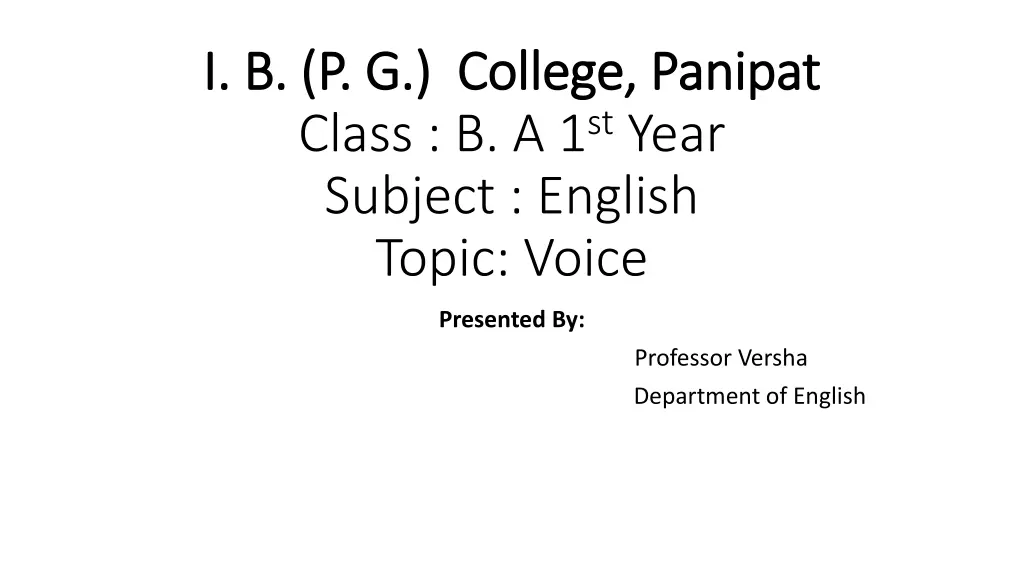
Understanding Voice in English Grammar
Learn about active voice and passive voice in English grammar, including examples and rules for changing tenses from active to passive. Explore how to transform sentences from active voice to passive voice for better communication skills.
Download Presentation

Please find below an Image/Link to download the presentation.
The content on the website is provided AS IS for your information and personal use only. It may not be sold, licensed, or shared on other websites without obtaining consent from the author. If you encounter any issues during the download, it is possible that the publisher has removed the file from their server.
You are allowed to download the files provided on this website for personal or commercial use, subject to the condition that they are used lawfully. All files are the property of their respective owners.
The content on the website is provided AS IS for your information and personal use only. It may not be sold, licensed, or shared on other websites without obtaining consent from the author.
E N D
Presentation Transcript
I. B. (P. G.) I. B. (P. G.) College, Panipat College, Panipat Class : B. A 1stYear Subject : English Topic: Voice Presented By: Professor Versha Department of English
Voice (Active Voice And Passive Voice) Voice (Active Voice And Passive Voice) A voice is the form of a verb which shows its connection with the subject. It tells us whether the subject does something or something is done to the subject. The Two Kinds Of Voice There are two kinds of voice. They are: (a) The Active Voice : In active voice, the verb shows that the subject does something. (b) The Passive Voice : The Passive voice shows that something is done to the subject.
Examples : Examples : Radha cleans the table. ( Active voice) The table is cleaned by Radha .(Passive Voice) Jyoti sang a song. (Active voice) A song was sung by Jyoti. (Passive voice) General Rules for changing the voice 1. The passive of an active tense is formed by putting the verb to be into the same tense as verb and adding the 3rdform of verb. 2. The object of the verb becomes the subject. 3. The subject of the verb in the active voice becomes the object of the verb in the passive. The preposition by is placed before it.
Rules for change of tenses Rules for change of tenses The following are the rules for changing tenses from active to passive voice : 1. Present Simple Tense Rule: is/am/are+3rdform of the verb. Active : Rushing writes a letter. Passive : A letter is written by Rishi. 2. Present Continuous Tense: Rule :is/am/are+being+3rdform. Active : The boys are playing a match. Passive : A match is being played by the boys.
3. 3. Present perfect : Present perfect : Rule:has/have+been+3rdform. Active : Shyam has taken breakfast. Passive : Breakfast has been taken by Shyam. 4. Present Perfect Continuous : There is no passive form in this tense. 5. Simple Past Tense : Rule :was/were+3rdform. Active : Sunidhi Chauhan sang a song. Passive : A song was sung by Sunidhi Chauhan.
6. 6. Past Continuous: Past Continuous: Rule:was/were+being +3rdform. Active : Arpita was watering the plants. Passive : The plants were being watered by Arpita. 7. Past Perfect Tense: Rule :had/been +3rdform. Active: Jagjit had mended the fence. Passive: The fence had been mended by Jagjit.
8. 8. Past Perfect Continuous Past Perfect Continuous There is no passive form in this tense. 9. Future Simple Tense: Rule :will/shall+be+3rdform. Active :I will paint the house. Passive:The house will be painted by me. 10. Future Continuous There is no passive form in this tense.
11. 11. Future Perfect Future Perfect Rule:will/shall+have+been+3rdform. Active : The doctor will have cured the patient. Passive : The patient will have been cured by the doctor. 12. Future Perfect Continuous There is no passive form in this tense.






















